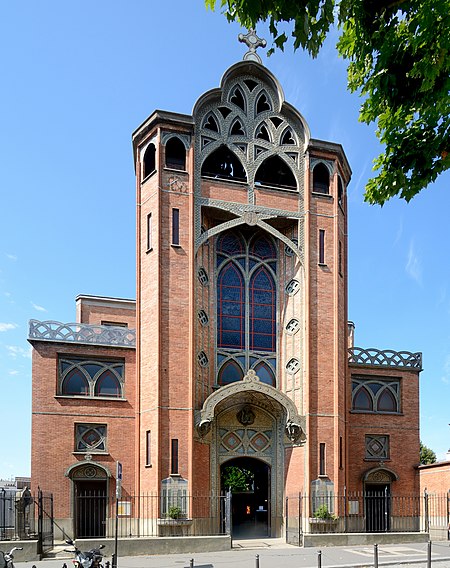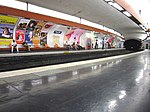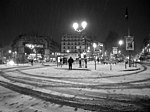Saint-Jean de Montmartre

Saint-Jean de Montmartre (French pronunciation: [sɛ̃ ʒɑ̃ d(ə) mɔ̃.maʁtʁ]) is a Roman Catholic parish church located at 19 Rue des Abbesses in the 18th arrondissement of Paris. Situated at the foot of Montmartre, it is notable as the first example of reinforced concrete in church construction. Built from 1894 through 1904, it was designed by architect Anatole de Baudot, a student of Viollet-le-Duc and Henri Labrouste. The brick and ceramic tile-faced structure exhibits features of Art Nouveau design while exploiting the superior structural qualities of reinforced concrete with lightness and transparency. The Art Nouveau stained glass was executed by Jac Galland according to the design of Pascal Blanchard. Interior sculpture was by Pierre Roche. The reinforced concrete structure followed a system developed by the engineer Paul Cottancin. Construction was attended by skepticism over the properties of the new material, which violated rules laid down for unreinforced masonry construction. A lawsuit delayed construction, resulting in a demolition order that was not resolved until 1902, when construction was resumed. There is a guided tour of the church on every fourth Sunday of the month at 4:00 PM.
Excerpt from the Wikipedia article Saint-Jean de Montmartre (License: CC BY-SA 3.0, Authors, Images).Saint-Jean de Montmartre
Rue des Abbesses, Paris 18th Arrondissement (Paris)
Geographical coordinates (GPS) Address Website External links Nearby Places Show on map
Geographical coordinates (GPS)
| Latitude | Longitude |
|---|---|
| N 48.884105555556 ° | E 2.3378833333333 ° |
Address
Église Saint-Jean de Montmartre
Rue des Abbesses 21
75018 Paris, 18th Arrondissement (Paris)
Ile-de-France, France
Open on Google Maps










